Upgrade your iMac: upgrade new iMac 21.5 ”
This article may be of interest to the owners of the new aimags of 2012-13 (these are flat and beautiful), as well as those who want to buy one for themselves. And it will save your finances. Those who asked the price know that the difference in price, between the simplest configuration and the maximum pumped, can reach almost two times.
Typically, Apple offers its computers in two (sometimes three) standard configurations, the simplest and cheapest (stock) and more advanced, which is more expensive (custom). Each of these configurations, for an additional fee, can be upgraded (memory, hard drive, processor, etc.).
Moreover, the upgrade, as a rule, is offered not equivalent. At the maximum, you can upgrade, usually only custom equipment, i.e. the consumer should initially pay more by choosing a more expensive version and then pay extra for the upgrade. This is such a marketing ploy.
We show an example. We take information from the Apple website, prices from there are in $ (and we must bear in mind that buying from us will be a bigger difference, those who wish can ask their price at our prices).
We go to the Apple website and watch the iMac 21.5 ”.
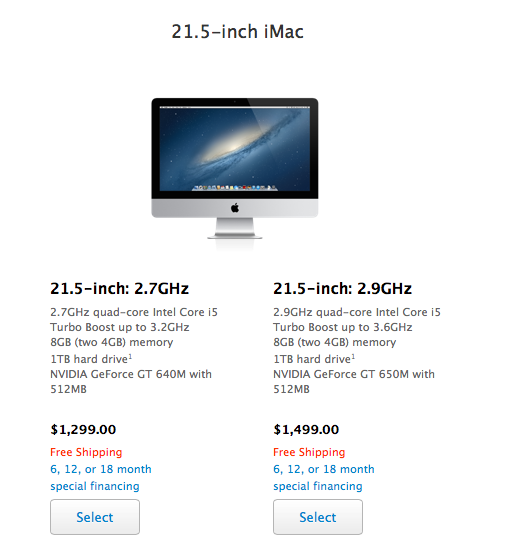
We see: the difference in processor frequency is 2.7 and 2.9, and the video differs from the GT 640M and GT 650M (the difference in video power is not significant). The difference is $ 200.
Next, we reveal the choice of options for the younger model.
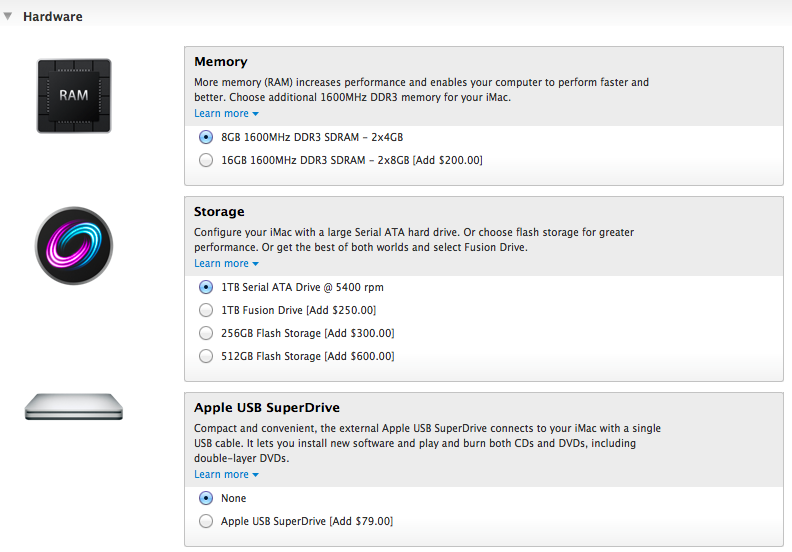
We see that it is only possible to increase memory to 16Gb and various options with hard drives and solid state drives.
We reveal the same tab for the older model.
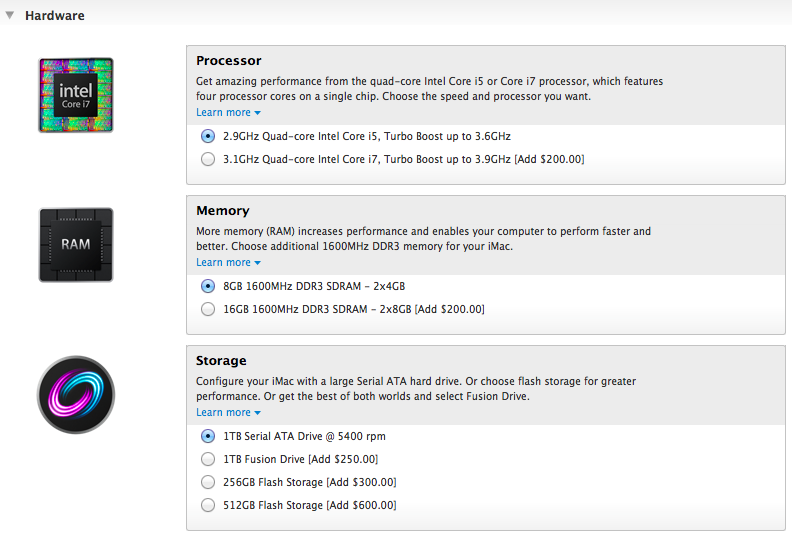
Here, in addition to the previous options, it became possible to replace the processor
with a Core i7 3.1GHz paying $ 200.
Now we count. To get the top processor we have to pay $ 400. And the retail price of such a processor is $ 300. We get a minimum overpayment of $ 100, and given that the old Core i5 2.9GHz processor (retail price of $ 200) remains with them and assuming that Intel’s wholesale prices for processors are much cheaper, we’ll see that Apple makes good money on such an upgrade .
But the most, it seems to us, is unfair in this, that the opportunity to put a top processor in a younger, cheaper model is not offered. Someone will think that this is impossible. But this is not so, we checked and everything worked fine.
It was all a digression, and now to the point.
The simplest iMac 21.5 ”with a Core i5 2.7GHz processor was purchased, the one for $ 1299 (in Moscow, on average, you can buy for 50t).
We put in it:
- Core i7-3770S 3.1GHz processor
- 16Gb RAM
- 2.5 '
' SSD solid state drive 240Gb - Flash Storage 512Gb (flash drive installed in the Fusion Drive configuration) from MacBook Pro Retina
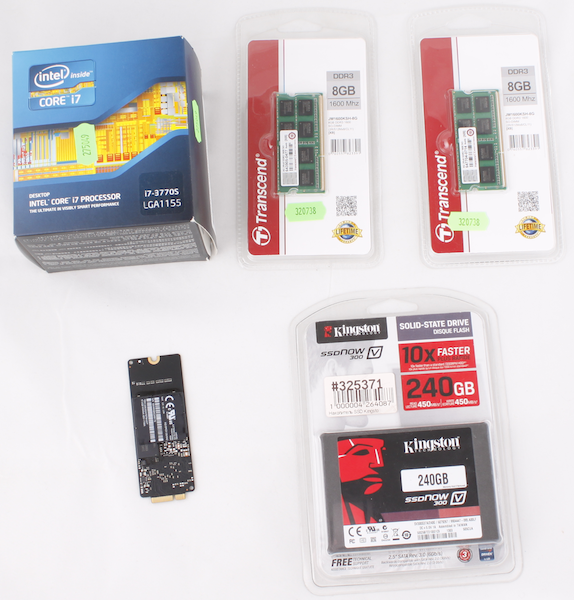
Instead of the regular ones:
- Core i5-3330S 2.7GHz processor
- 8Gb RAM
- HDD 2.5 ”1Tb.
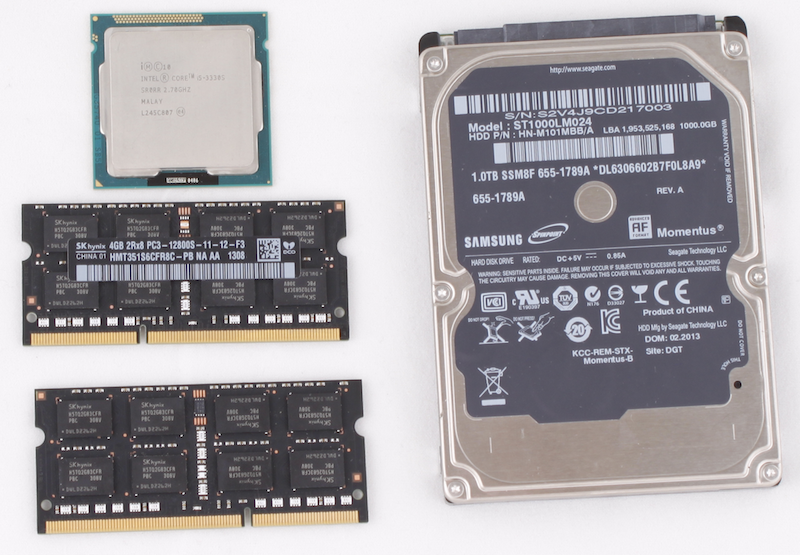
Moreover, the whole procedure of such an upgrade can be done independently, unless of course there is experience in such work and if there are“ straight ”hands. In general, a soldering iron is not required.
We will tell in more detail. We won’t give complete instructions for parsing, it is very well shown on iFixit and there was already a post on the hub (http://habrahabr.ru/post/161033/). You will have to disassemble completely to pull out the motherboard. As you know, in this model, to simply replace the RAM, you will need a complete analysis.
This aimak is easier to understand than previous generations. Inside, everything has become much simpler; there are not so many connecting loops. The only thing to do with great care is to remove the screen module (the protective glass and the matrix are glued and this is now one part).
The screen is glued to double-sided tape. In iFixit it was pre-heated with a hairdryer, but we shoot in a slightly different way. The adhesive tape on which the screen is attached, it is voluminous, with a filler, and it can be carefully cut along the perimeter (more precisely from three sides). And after that, the screen easily leaves, not even a suction cup is required. This should be done with a very thin plastic card (in no case do not use an iron tool!). We use packaging plastic, for example from packaging RAM.
So. We got the board: pull out the memory, unscrew the heat sink, remove the processor.
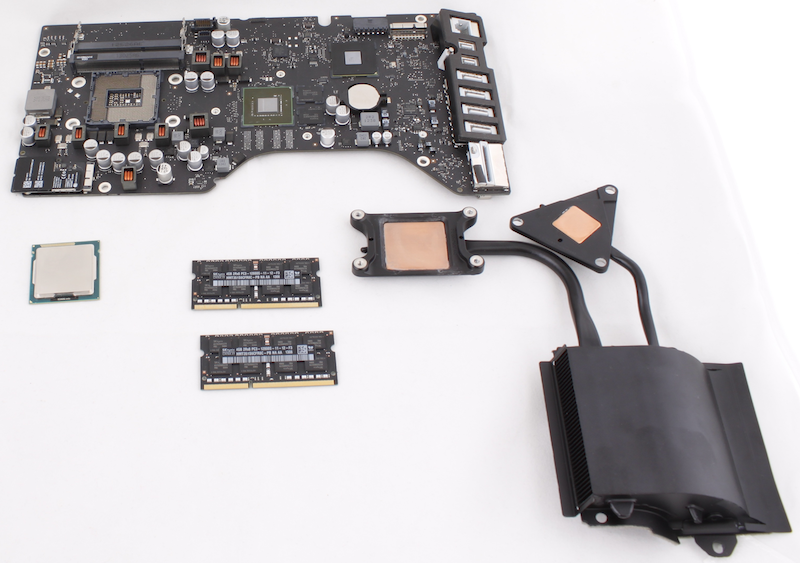
Instead of the standard i5-3330S 2.7GHz.

We set the i7-3770S 3.1GHz.
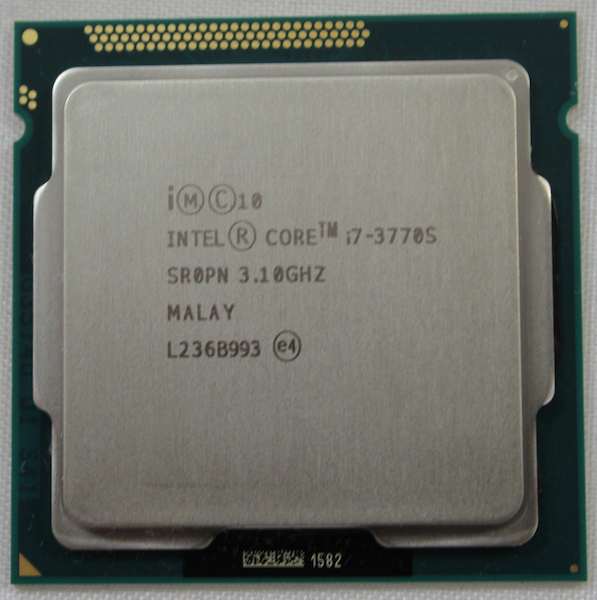
The Core i7-3770S, the processor that is optional, is offered in the maximum configuration. This is the third generation of the Core family of processors (codenamed Ivy Bridge), the LGA1155 socket. The 3770 series has four processors.
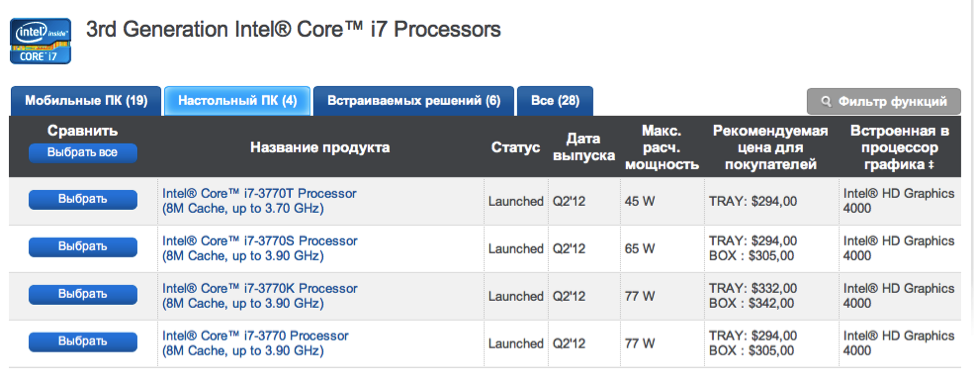
Theoretically, any of them will work, but the 3770S has a heat output of 65W., It is exactly the same as the regular Core i5-3330S. And so if you put 77W, then there is a risk that the cooling system will not cope.
Next, install the “Retin” ssd (Flash Storage) on 512GB. The connector and mounts on the board, specifically for a disk of this format. Interesting that the materials
iFixit, in a simple configuration, there was no connector for a flash drive.
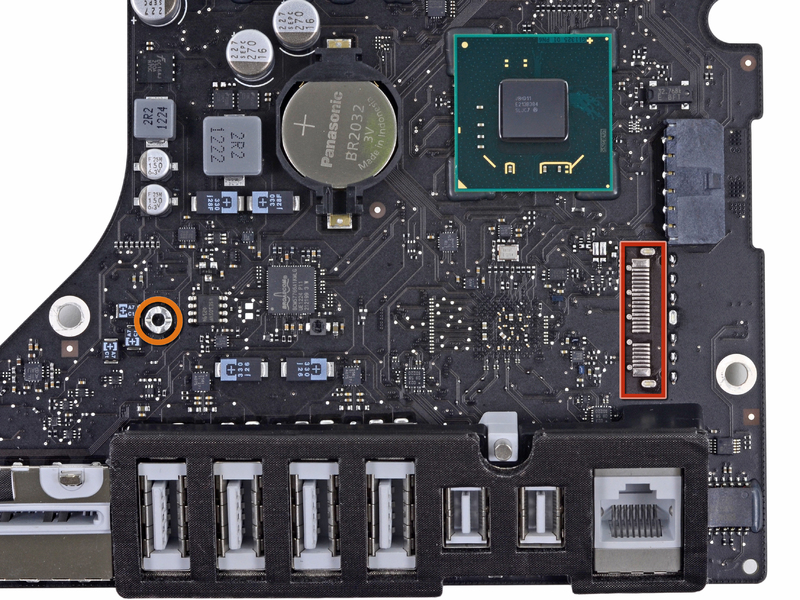
Perhaps this was only in the very first batches of boards, because there is a connector on our board.
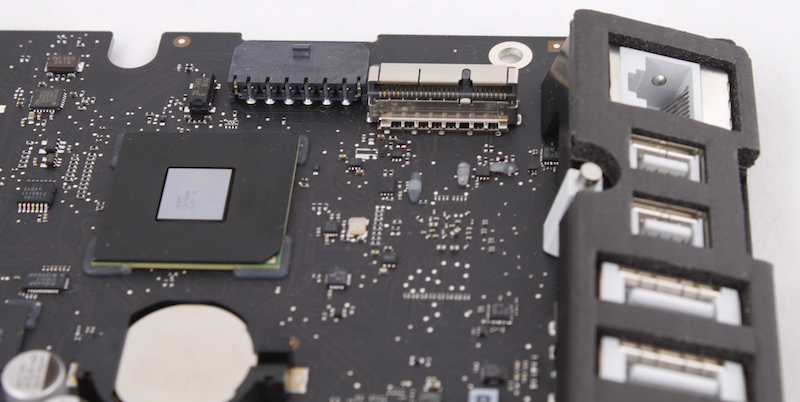
Install and fasten the drive.
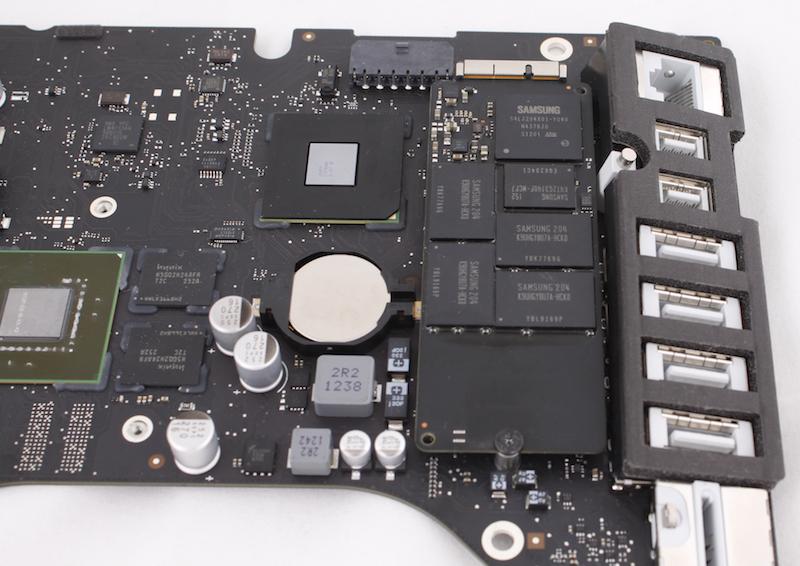
But even with the absence of a connector, theoretically it can be soldered and a flash drive installed.
In conclusion, install the memory. There are only two slots, so a maximum of 16Gb, although the processor supports 32Gb. Any DDR3 SO-DIMM with a frequency of 1600MHz (PC3-12800) is suitable for memory.
Now everything is ready for reassembly.
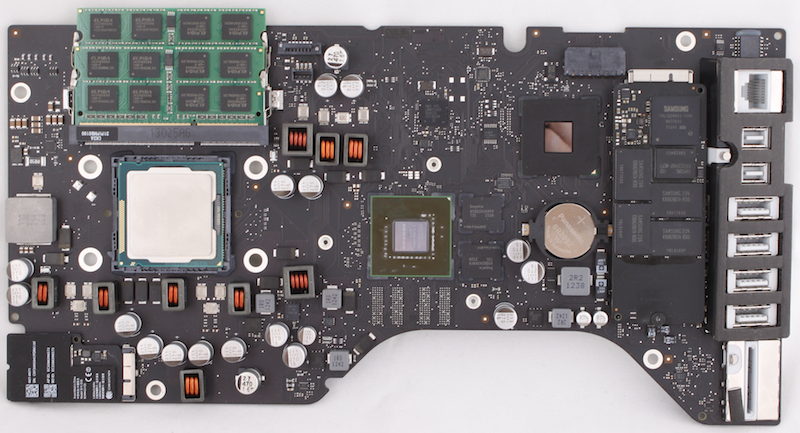
We apply thermal grease, fasten the radiator and assemble everything in the reverse order.
We replaced the regular 2.5 ”1Tb HDD with a 2.5” 240Gb SSD. Any one will do. They did this simply for the purposes of the experiment, in order to make sure that there are no problems with such a replacement.
As a result, it turned out that we replaced everything that could be replaced and it worked. It turned out the maximum pumped iMac.
Only the video system is not amenable to upgrade. Theoretically, the GF 640M video chip itself can be soldered to the GF 650M (the one in the custom configuration) and it will have to work. But this makes no sense, the difference between them is insignificant.
It is also interesting that in both trim levels only 512Mb of video memory is offered. At the same time, only two memory chips are soldered on the board and two more empty places remain. That is, you can install 1Gb of video memory and the chip itself supports this amount. But such a configuration with 1Gb is not offered even as an option.
And finally, a few screenshots.
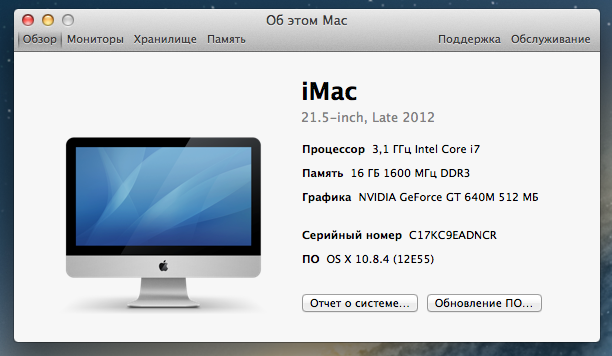
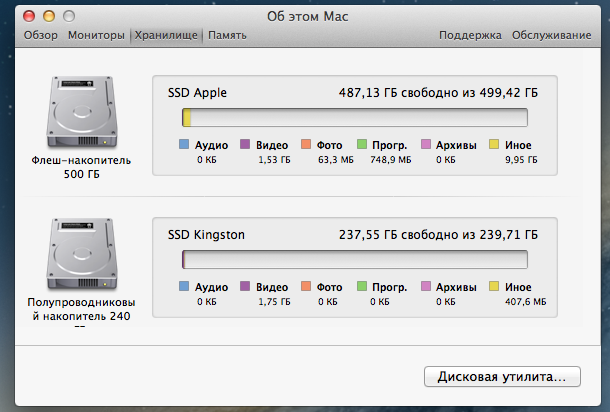
And the results of the Cinebench test.
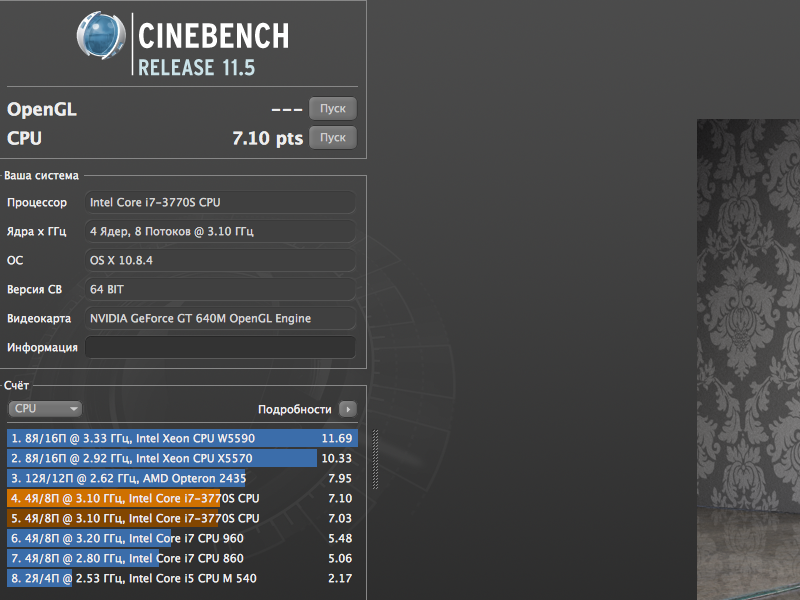

Typically, Apple offers its computers in two (sometimes three) standard configurations, the simplest and cheapest (stock) and more advanced, which is more expensive (custom). Each of these configurations, for an additional fee, can be upgraded (memory, hard drive, processor, etc.).
Moreover, the upgrade, as a rule, is offered not equivalent. At the maximum, you can upgrade, usually only custom equipment, i.e. the consumer should initially pay more by choosing a more expensive version and then pay extra for the upgrade. This is such a marketing ploy.
We show an example. We take information from the Apple website, prices from there are in $ (and we must bear in mind that buying from us will be a bigger difference, those who wish can ask their price at our prices).
We go to the Apple website and watch the iMac 21.5 ”.

We see: the difference in processor frequency is 2.7 and 2.9, and the video differs from the GT 640M and GT 650M (the difference in video power is not significant). The difference is $ 200.
Next, we reveal the choice of options for the younger model.

We see that it is only possible to increase memory to 16Gb and various options with hard drives and solid state drives.
We reveal the same tab for the older model.

Here, in addition to the previous options, it became possible to replace the processor
with a Core i7 3.1GHz paying $ 200.
Now we count. To get the top processor we have to pay $ 400. And the retail price of such a processor is $ 300. We get a minimum overpayment of $ 100, and given that the old Core i5 2.9GHz processor (retail price of $ 200) remains with them and assuming that Intel’s wholesale prices for processors are much cheaper, we’ll see that Apple makes good money on such an upgrade .
But the most, it seems to us, is unfair in this, that the opportunity to put a top processor in a younger, cheaper model is not offered. Someone will think that this is impossible. But this is not so, we checked and everything worked fine.
It was all a digression, and now to the point.
The simplest iMac 21.5 ”with a Core i5 2.7GHz processor was purchased, the one for $ 1299 (in Moscow, on average, you can buy for 50t).
We put in it:
- Core i7-3770S 3.1GHz processor
- 16Gb RAM
- 2.5 '
' SSD solid state drive 240Gb - Flash Storage 512Gb (flash drive installed in the Fusion Drive configuration) from MacBook Pro Retina

Instead of the regular ones:
- Core i5-3330S 2.7GHz processor
- 8Gb RAM
- HDD 2.5 ”1Tb.

Moreover, the whole procedure of such an upgrade can be done independently, unless of course there is experience in such work and if there are“ straight ”hands. In general, a soldering iron is not required.
We will tell in more detail. We won’t give complete instructions for parsing, it is very well shown on iFixit and there was already a post on the hub (http://habrahabr.ru/post/161033/). You will have to disassemble completely to pull out the motherboard. As you know, in this model, to simply replace the RAM, you will need a complete analysis.
This aimak is easier to understand than previous generations. Inside, everything has become much simpler; there are not so many connecting loops. The only thing to do with great care is to remove the screen module (the protective glass and the matrix are glued and this is now one part).
The screen is glued to double-sided tape. In iFixit it was pre-heated with a hairdryer, but we shoot in a slightly different way. The adhesive tape on which the screen is attached, it is voluminous, with a filler, and it can be carefully cut along the perimeter (more precisely from three sides). And after that, the screen easily leaves, not even a suction cup is required. This should be done with a very thin plastic card (in no case do not use an iron tool!). We use packaging plastic, for example from packaging RAM.
So. We got the board: pull out the memory, unscrew the heat sink, remove the processor.

Instead of the standard i5-3330S 2.7GHz.

We set the i7-3770S 3.1GHz.

The Core i7-3770S, the processor that is optional, is offered in the maximum configuration. This is the third generation of the Core family of processors (codenamed Ivy Bridge), the LGA1155 socket. The 3770 series has four processors.

Theoretically, any of them will work, but the 3770S has a heat output of 65W., It is exactly the same as the regular Core i5-3330S. And so if you put 77W, then there is a risk that the cooling system will not cope.
Next, install the “Retin” ssd (Flash Storage) on 512GB. The connector and mounts on the board, specifically for a disk of this format. Interesting that the materials
iFixit, in a simple configuration, there was no connector for a flash drive.

Perhaps this was only in the very first batches of boards, because there is a connector on our board.

Install and fasten the drive.

But even with the absence of a connector, theoretically it can be soldered and a flash drive installed.
In conclusion, install the memory. There are only two slots, so a maximum of 16Gb, although the processor supports 32Gb. Any DDR3 SO-DIMM with a frequency of 1600MHz (PC3-12800) is suitable for memory.
Now everything is ready for reassembly.

We apply thermal grease, fasten the radiator and assemble everything in the reverse order.
We replaced the regular 2.5 ”1Tb HDD with a 2.5” 240Gb SSD. Any one will do. They did this simply for the purposes of the experiment, in order to make sure that there are no problems with such a replacement.
As a result, it turned out that we replaced everything that could be replaced and it worked. It turned out the maximum pumped iMac.
Only the video system is not amenable to upgrade. Theoretically, the GF 640M video chip itself can be soldered to the GF 650M (the one in the custom configuration) and it will have to work. But this makes no sense, the difference between them is insignificant.
It is also interesting that in both trim levels only 512Mb of video memory is offered. At the same time, only two memory chips are soldered on the board and two more empty places remain. That is, you can install 1Gb of video memory and the chip itself supports this amount. But such a configuration with 1Gb is not offered even as an option.
And finally, a few screenshots.


And the results of the Cinebench test.


